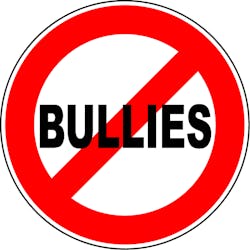What trucking can learn from the Miami Dolphins bullying scandal
By now, most of you have probably heard about the Miami Dolphins’ bullying scandal in which one player is accused of bullying another until he left the team.
The player alleged to have carried out the bullying has been suspended. According to various reports, he may or may not have been carrying out a directive from the team’s coaches to “toughen up” the victim. The National Football League is now investigating, but people are already taking sides, as they do in these situations.
So what does an NFL scandal have to do with trucking? As it turns out, there are a lot of similarities between an NFL locker room and a trucking company. And it all starts with the workplace environment.
How many times has a truck driver felt the wrath of a dispatcher because a load was late? Or a driver was told to ignore the fact that he has reached his maximum driving hours and keep driving? Are these instances of bullying?
We hear stories of kids who are bullied in school, and when we hear them after the fact, there is usually no doubt that bullying took place. But what about in the workplace?
According to the Workplace Bullying Institute (WBI), 35% of adult American workers (an estimated 54 million in the last report published in 2010) report being bullied at work. Just as problematic is that 50% have either been bullied or seen bullying taking place in the workplace.
That means that half of your workers right now believe they are being bullied by someone in the workplace or know of someone being bullied in the workplace. In your workplace. Right now.
But what is bullying? Is the dispatcher-driver scenarios I mentioned earlier instances of bullying or just management techniques? WBI defines workplace bullying as “repeated, health-harming mistreatment of one or more persons (the targets) by one or more perpetrators.” It takes the form of verbal abuse; threatening, humiliating or intimidating conduct; work interference or sabotage that prevents work from getting done; or exploitation of a known psychological or physical vulnerability.
(Dr. Gary Namie, director of the Workplace Bullying Institute, talks about workplace bullying in the video below)
According to the Institute, what bullying is not is “incivility, simple rudeness, or the routine exercise of acceptable managerial prerogative.”
And that is where the identification of workplace bullying gets murky. Is a manager who doesn’t know how to manage people a bully, or just ineffective? Is it a management style that an employee doesn’t respond to (as we know, everyone is wired differently and what is appropriate conduct to one is not to the other) or a forceful way for a manager to manipulate and embarrass workers into performing?
And, let’s not place all of this on management. Co-workers can also be bullies, and in many cases, this can be even more difficult to root out.
Imagine a worker who is underperforming because he is being bullied at work and, as WBI indicates happens, it prevents him from doing his job correctly. He reports the problem to management, who then begins an investigation. Is he a bad employee because he doesn’t do his job and that is the reason why he is being picked on by co-workers? Or is the behavior of the co-workers turning a good employee into a poor worker? Management must decide and the decision may not always be the correct one.
I don’t know that the Workplace Bullying Institute’s figure of 35% of employees feeling bullied is correct – I’ve read other articles with “experts” who cite figures closer to 15-17% and still others with figures in between the two – but I do know that there is no place for bullying – in schools, on playgrounds, in homes, or in the workplace. Even a single employee being bullied is too many.
WBI offers programs (self-guided DVDs or in-person consultation, books and videos) to assist with workplace bullying, from helping write policies and procedures to reviews of current policies. It also offers programs to help employees understand what is and what is not bullying and how management can make the work environment bully-free.
You may not feel that bullying is a problem in your workplace – but statistically speaking, you would be wrong. I encourage each employer to review their policies or implement policies that forbid workplace bullying. Simply putting a policy in place, though, is not enough. It must be followed up with some form of education, employees must be aware of clear procedures to follow to report bullying, and management must take these allegations seriously.
The website Bullying Statistics reports that 4,400 young people commit suicide each year. The site notes that the Centers for Disease Control and Prevention (CDC) estimates that for each suicide among young people, there are 100 suicide attempts and bullying victims are between 2 and 9 times more likely to consider suicide. According to ABC News, nearly 30% of students are either bullies or victims of bullying.
That number sounds similar to the numbers reported regarding workplace bullying. After all, statistics have shown that kids who are bullied have a greater tendency to grow up and be bullies themselves. If the numbers are even remotely true, it is reasonable to assume that some percentage of the nearly 35,000 yearly suicides (according to the CDC) that take place in this country are attributable to bullying – even among adults.
The cruel truth is that workplace bullying is not discussed and rarely reported, but it is occurring. Right now. And likely in your workplace.
You owe it to all your employees to make the work environment a safe and welcoming place for business to occur.
If you feel you are being victimized by a bully in the workplace, the Workplace Bullying Institute can help. Click here for resources that can assist you.

